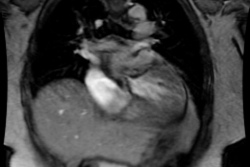Radiology 2001 Sep;220(3):707-11
Effect of electrocardiogram triggering on reproducibility of coronary artery
calcium scoring.
Mao S, Bakhsheshi H, Lu B, Liu SC, Oudiz RJ, Budoff MJ.
PURPOSE: To test the hypothesis that computed tomographic (CT) scanning during
early rather than middle diastole can significantly reduce the interscan
variability of coronary artery calcium (CAC) scores. MATERIALS AND METHODS: Five
hundred thirty-eight patients were initially enrolled; 282 of them were found to
have CAC at electron-beam CT and underwent repeat scanning to measure interscan
variability with different electrocardiogram (ECG) triggers. Eight patients were
excluded owing to respiratory motion; thus, 274 asymptomatic patients were
examined. Patients were randomly assigned to different ECG trigger interval
groups: 40% (group 1), 50% (group 2), 60% (group 3), and 80% (group 4). Patients
in whom more than one-third of sections had greater than 10% ECG trigger
variability were classified in the untriggered group (group 5). Interscan
variation was compared among all five groups. RESULTS: Interscan variabilities
in CAC groups 1-5 were 11.5%, 15.3%, 20.3%, 17.4%, and 33.1%, respectively, for
total calcium area, and 15.0%, 23.3%, 25.6%, 24.0%, and 42.4%, respectively, for
total calcium score. CAC score variability was reduced by 34%; and calcium area
variability, by 38% in group 1, as compared with the reduced variabilities in
group 4 (P <.01 for both measures). Breath holding was adequate in 812 cases,
and ECG triggering was correct in 790 of cases. CONCLUSION: Study results
strongly support the use of an ECG trigger of 40% rather than 80% of the R-R
interval in electron-beam CT calcium studies.





